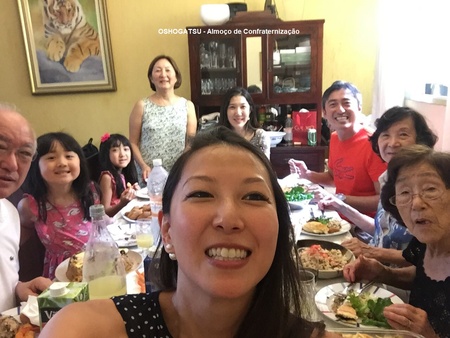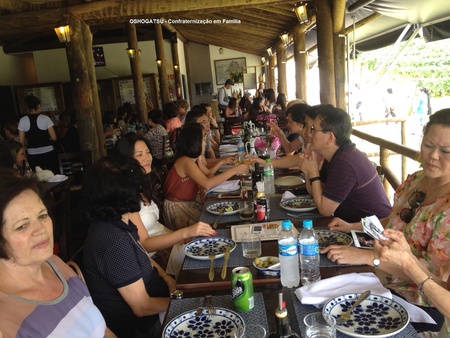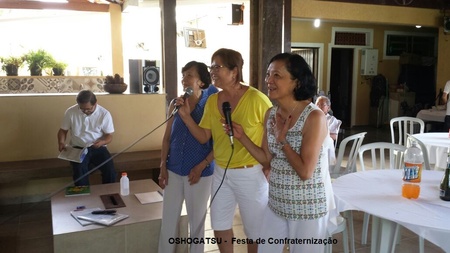Oshogatsu (New Year) is the most important celebration in the Japanese calendar. Even here in Brazil, with its eminently Christian culture, the date is celebrated by the Nikkei community – not with the same intensity and importance as Christmas, but always in a respectful and festive manner.
I’ve noticed that among the Nikkei families that have settled here the date is celebrated in different ways, depending on the greater or lesser assimilation of the Japanese culture within that social group and on the physical presence of the ojiichan and obaachan, who end up having a major influence on the habits and customs of each family.
While doing a little memory exercise, like a flashback of my life from the distant past, having covered so much ground since that time, I remember very little about Oshogatsu celebrations that could be considered memorable during my childhood, when I was still living in Tupã, in the interior of the state of São Paulo. In all honesty, no significant recollection from this period comes to mind and I face this fact with a certain melancholy. In that regard, I even asked my mother, who, thank God, is still giving us the privilege of her presence at almost 97 years old. She answered, with an air of lamentation and resignation, that really, it was never possible to celebrate these occasions as they (my parents and grandparents) would have liked because they spent all their time working: 362 days a year, running a small business (a bar and ice cream shop), where there were no breaks at all, and they couldn’t even find time to get sick. They worked from Monday to Sunday, rain or shine, even on holidays and other holy days. They were allowed to relax only in the first three days of the year – that’s right during Oshogatsu – the only time when they closed shop. She then proceeds to reinforce her remark that “these three days didn’t mean parties. We used them to get some rest,” as if it were possible to get rid of all the fatigue accumulated during the course of the year in just three days. Mom also stated that the biggest luxury they could afford in those days was to savor some ozoni (mochi soup), roast chicken, pork, and sushi or inarizushi, all prepared by obaachan, with Mom’s help. A poignant observation that I found quite moving was the revelation that she felt fulfilled only when, in her precious few spare moments, she was able to make some new clothes for me and my other siblings, ranging in age from 2 to 11. There were five of us. It was her New Year's gift to us!
She said that another custom that was usually part of the Oshogatsu traditions was to visit relatives and vice versa so as to give Akemashite omedetou wishes – however, that was not possible in our family. That was due to the absolute lack of time to which they were subjected and the physical distance that separated them from their relatives, an obstacle that could easily be overcome today thanks to the existence of automobiles and modern highways, which have drawn closer together cities seemingly distant at that time.
Many years later, by then I was already living in the city of São Paulo, still single but already with a set professional goal and finishing up college; my other siblings also continuing their studies and working at the same time, and already living in their own homes; and our ojiichan and Dad almost retired, I remember that Christmas celebrations took priority while the Oshogatsu became restricted to the ozoni with baked mochi, served with shoyu and sugar, lovingly prepared by Mom and served early in the morning. It was delicious; everyone liked it then and they still like it even today!
For lunch, something more elaborate was served, like the usual roasted chicken, onishime (vegetable stew), in addition to sushi and sekihan (rice with azuki beans). In the afternoon, after coffee, a custom that eventually became mandatory each year, on the first day of the year: my parents and grandparents watching reruns of the indispensable TV show Kohaku Utagassen, broadcast by the Japanese station NHK.
With the passing of my grandparents and, later on, of my father, who left us 12 years ago, what little remains of those more traditional customs, that is, our cultural heritage, has been concentrated on Dona (D.) Aiko, this almost iconic family figure who, with her well-lived 96 years and lucidity to spare, still has the capacity to bring the group together, with her five children, daughters-in-law, grandchildren, and great-grandchildren, chiefly on special dates like Mother's Day, Father's Day, and Christmas, when she goes overboard with the gochisou. At these occasions, her incomparable flair for cooking is made manifest – her delicacies providing much enjoyment to her guests. Who could resist her pork legs, pork ribs, cod cakes, breaded shrimp, lasagna with the dough prepared from scratch, sushi, sekihan, onishime? Enchanting everyone with her culinary gift and her charisma, D. Aiko achieves the feat of reuniting the whole family around her, an increasingly rare picture in our times. There’s hardly ever a “pass”; attendance is full. Even the great-granddaughters marvel at their great-grandmother. “Great-granny, would you make some raindrop doughnuts for me?” daintily asks Carol, at the age of 8, the oldest of the great-granddaughters.
From the first generation – those who came from Japan – the only one left is D. Aiko, and for that reason our Oshogatsu celebrations are losing more and more of their original characteristics, having basically become limited to the New Year's Eve celebrations on the night of December 31. Gathered in the house of one of her children or relatives, among those who have remained in town, we celebrate the arrival of the new year at a table filled with dishes such as grilled chicken, pork loin, green salad, and other delicacies, and where the indispensable soba (buckwheat noodles) is always available for good luck, a remnant of old customs. As the family matriarch, at these occasions D. Aiko gladly takes turns, going from one place to another, enjoying Christmas supper at the house of one of her children one year, and then the following year she’s invited by another child, and thus she goes on fulfilling her role, with the grace of God.
It’s worth pointing out something that has been taking place in recent years in our family environment, and which I consider auspicious and encouraging. With the absence of the grandparents, parents, uncles and aunts, and the older members of the family, a new awareness has arisen for the need to do something to preserve all this rich and wonderful culture passed on by the elders, so that our children and grandchildren can get to know and enjoy it in the future. In addition, so that the family ties among siblings, cousins, and nephews and nieces can be perpetuated in face of the dismembering and distancing tendencies that exist nowadays within the younger generations, seemingly little concerned with the preservation of such ties and of Japanese culture itself.
Consequently, in order to strengthen the Oshogatsu celebrations, the New Year gatherings have been stepped up, always in the mochiyori system, with the participation of uncles and aunts, cousins, nephews and nieces, and held in some hall kindly provided by a member – where the guests spend a pleasant, cheerful day, with plenty of food made even more enjoyable by some bingo and karaoke fun. The reunion of relatives who had not seen each other for a while somehow ends up tightening these family bonds.
That’s what could recently be noticed, when some cousins, owners of a beautiful and well-crafted country house near the city of São Paulo, offered their place for the event. On account of the available perks – a pleasant and comfortable place, the hosts’ friendliness, and the abundance of food offered in the mochiyori system – one comes to the realization that the goal has been achieved, as the number of participants has increased more and more. As a plus, the guests enjoy a karaoke show, during which a few cousins, expert enka music performers, deliver a great, tuneful gig to those who are into it.
It’s a Brazilian-style Oshogatsu party, but it’s a lot of fun and very lively. Besides the spirit of communion, it helps to welcome the New Year and to refreshen the mood of all those present so they can face the tough battles awaiting in the new year.
Yoi otoshi wo omukae kudasai! Happy New Year!
© 2017 Katsuo Higuchi









